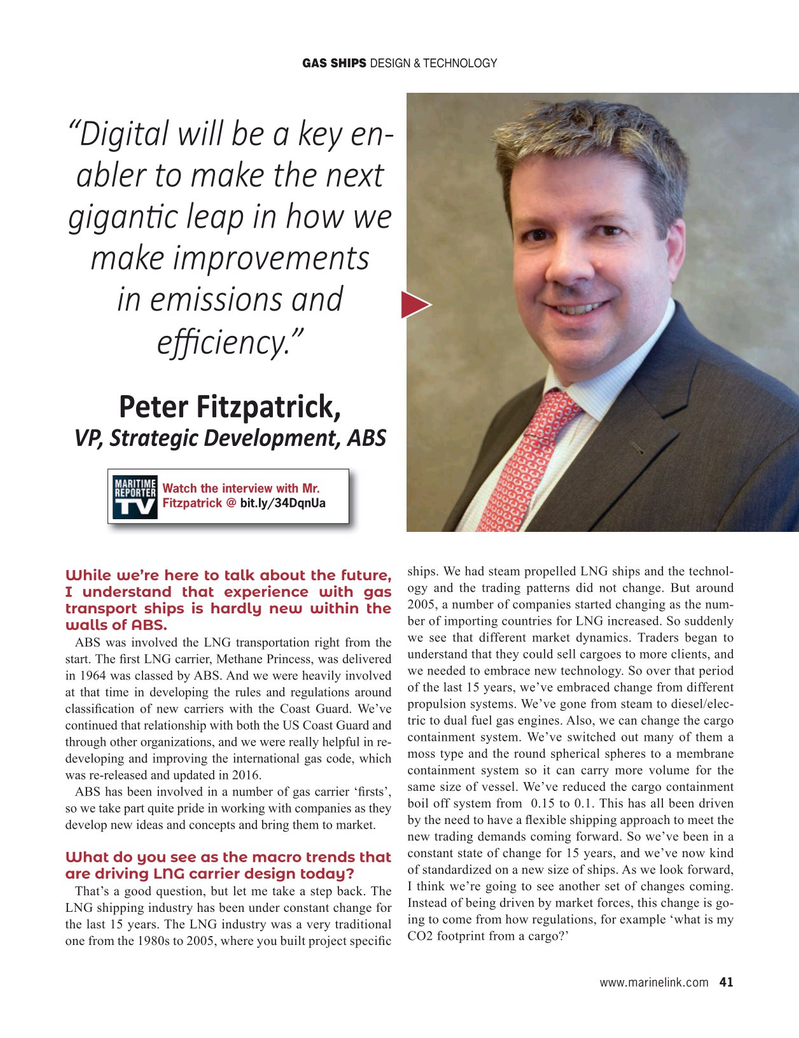
Page 41: of Maritime Reporter Magazine (June 2021)
USCG Fleet Modernization Annual
Read this page in Pdf, Flash or Html5 edition of June 2021 Maritime Reporter Magazine
GAS SHIPS DESIGN & TECHNOLOGY “Digital will be a key en- abler to make the next giganO c leap in how we make improvements in emissions and e? ciency.”
Peter Fitzpatrick,
VP, Strategic Development, ABS
Watch the interview with Mr.
Fitzpatrick @ bit.ly/34DqnUa ships. We had steam propelled LNG ships and the technol-
While we’re here to talk about the future, ogy and the trading patterns did not change. But around
I understand that experience with gas 2005, a number of companies started changing as the num- transport ships is hardly new within the ber of importing countries for LNG increased. So suddenly walls of ABS.
ABS was involved the LNG transportation right from the we see that different market dynamics. Traders began to start. The ? rst LNG carrier, Methane Princess, was delivered understand that they could sell cargoes to more clients, and in 1964 was classed by ABS. And we were heavily involved we needed to embrace new technology. So over that period at that time in developing the rules and regulations around of the last 15 years, we’ve embraced change from different classi? cation of new carriers with the Coast Guard. We’ve propulsion systems. We’ve gone from steam to diesel/elec- tric to dual fuel gas engines. Also, we can change the cargo continued that relationship with both the US Coast Guard and containment system. We’ve switched out many of them a through other organizations, and we were really helpful in re- developing and improving the international gas code, which moss type and the round spherical spheres to a membrane containment system so it can carry more volume for the was re-released and updated in 2016.
ABS has been involved in a number of gas carrier ‘? rsts’, same size of vessel. We’ve reduced the cargo containment boil off system from 0.15 to 0.1. This has all been driven so we take part quite pride in working with companies as they by the need to have a ? exible shipping approach to meet the develop new ideas and concepts and bring them to market. new trading demands coming forward. So we’ve been in a constant state of change for 15 years, and we’ve now kind
What do you see as the macro trends that of standardized on a new size of ships. As we look forward, are driving LNG carrier design today?
That’s a good question, but let me take a step back. The I think we’re going to see another set of changes coming.
LNG shipping industry has been under constant change for Instead of being driven by market forces, this change is go- the last 15 years. The LNG industry was a very traditional ing to come from how regulations, for example ‘what is my one from the 1980s to 2005, where you built project speci? c CO2 footprint from a cargo?’ www.marinelink.com 41
MR #6 (34-49).indd 41 6/3/2021 3:44:16 PM

 40
40

 42
42
